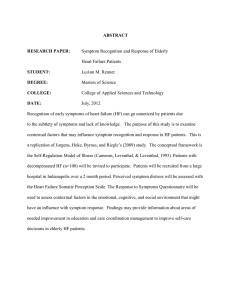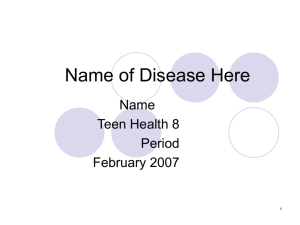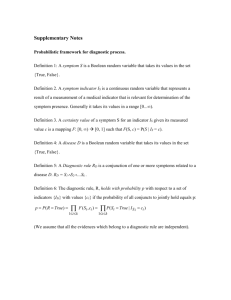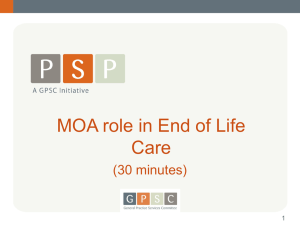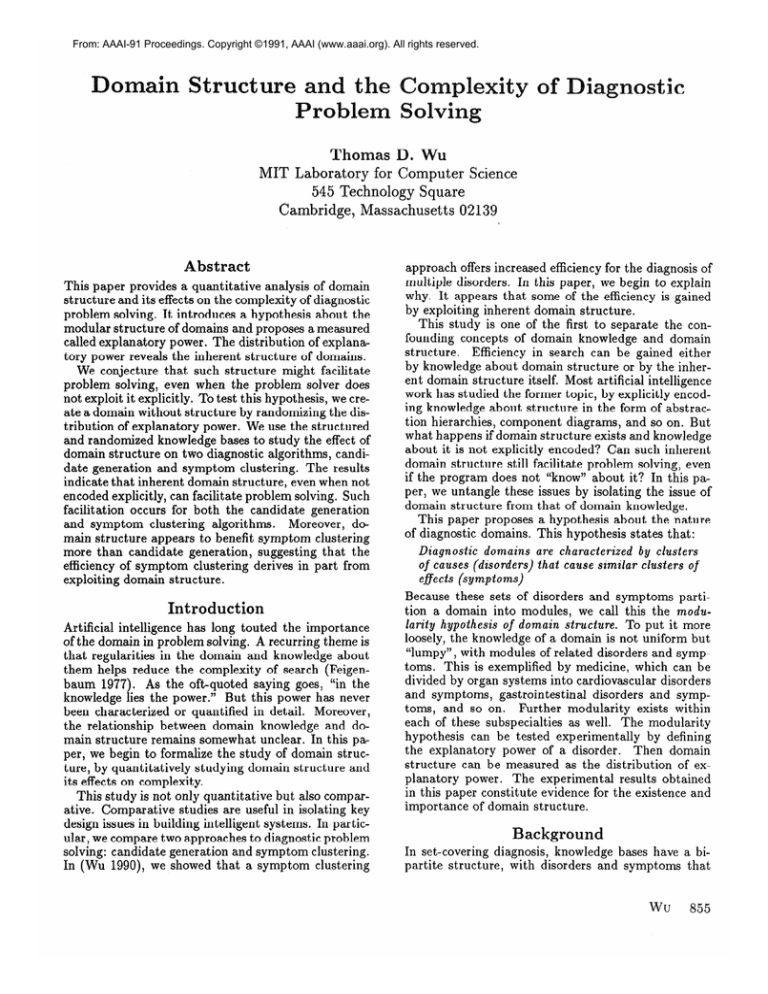
From: AAAI-91 Proceedings. Copyright ©1991, AAAI (www.aaai.org). All rights reserved.
Thomas De Wu
MIT Laboratory for Computer Science
545 Technology Square
Cambridge, Massachusetts
02139
Abstract
This paper provides a quantitative analysis of domain
structure and its effects on the complexity of diagnostic
problem solving. It introduces a hypothesis about the
modular structure of domains and proposes a measured
called explanatory power. The distribution of explana
tory power reveals the inherent structure of domains.
We conjecture that such structure might facilitate
problem solving, even when the problem solver does
not exploit it explicitly. To test this hypothesis, we create a domain without structure by randomizing the distribution of explanatory power. We use the structured
and randomized knowledge bases to study the effect of
domain structure on two diagnostic algorithms, candidate generation and symptom clustering. The results
indicate that inherent domain structure, even when not
encoded explicitly, can facilitate problem solving. Such
facilitation occurs for both the candidate generation
and symptom clustering algorithms.
Moreover, domain structure appears to benefit symptom clustering
more than candidate generation, suggesting that the
efficiency of symptom clustering derives in part from
exploiting domain structure.
Introduction
Artificial intelligence has long touted the importance
of the domain in problem solving. A recurring theme is
that regularities in the domain and knowledge about
them helps reduce the complexity of search (Feigenbaum 1977). As the oft-quoted saying goes, “in the
knowledge lies the power.” But this power has never
been characterized or quantified in detail. Moreover,
the relationship between domain knowledge and domain structure remains somewhat unclear. In this pa
per, we begin to formalize the study of domain structure, by quantitatively studying domain structure and
its effects on complexity.
This study is not only quantitative but also comparative. Comparative studies are useful in isolating key
design issues in building intelligent systems. In particular, we compare two approaches to diagnostic problem
solving: candidate generation and symptom clustering.
In (Wu 1990), we showed that a symptom clustering
approach offers increased efficiency for the diagnosis of
multiple disorders. In this paper, we begin to explain
why. It appears that some of the efficiency is gained
by exploiting inherent domain structure.
This study is one of the first to separate the confounding concepts of domain knowledge and domain
structure. Efficiency in search can be gained either
by knowledge about domain structure or by the inherent domain structure itself. Most artificial intelligence
work has studied the former topic, by explicitly encoding knowledge about structure in the form of abstraction hierarchies, component diagrams, and so on. But
what happens if domain structure exists and knowledge
about it is not explicitly encoded? Can such inherent
domain structure still facilitate problem solving, even
if the program does not “know” about it? In this paper, we untangle these issues by isolating the issue of
domain structure from that of domain knowledge.
This paper proposes a hypothesis about the nature
of diagnostic domains. This hypothesis states that:
Diagnostic domains
of causes (disorders)
eflects (symptoms)
are characterized
by clusters
that cause similar clusters of
Because these sets of disorders and symptoms partition a domain into modules, we call this the modularity hypothesis of domain structure.
To put it more
loosely, the knowledge of a domain is not uniform but
“lumpy”, with modules of related disorders and symptoms. This is exemplified by medicine, which can be
divided by organ systems into cardiovascular disorders
and symptoms, gastrointestinal disorders and symptoms, and so on. Further modularity exists within
each of these subspecialties as well. The modularity
hypothesis can be tested experimentally by defining
the explanatory power of a disorder. Then domain
structure can be measured as the distribution of explanatory power. The experimental results obtained
in this paper constitute evidence for the existence and
importance of domain structure.
Background
In set-covering diagnosis, knowledge bases have a bipartite structure, with disorders and symptoms that
WV
855
are linked whenever a disorder can cause a symptom.
Each disorder has a set of possible effects, called its
disorder profile. Each symptom has a set of possible causes, called its symptom profile (called a conflict
set in the literature). These are the disorders in the
knowledge base that have can cause that symptom. A
diagnostic problem, or case, consists of a set of symptoms to be explained. In the general case, links in
the knowledge base can have conditional probabilities
and disorders can have prior probabilities, but in this
study we restrict ourselves to the task of categorical
diagnosis.
Candidate generation (de Kleer & Williams 1987,
Reggia, Nau, & Wang 1983, Reiter 1987) is a method
for converting a set of symptom profiles to a set of
minimal candidates. A candidate is a set of disorders
that constitutes a proposed solution to the diagnostic
problem. A candidate is valid when it explains all of
the given symptoms. A candidate is minimal when it
is valid and no proper subset of the candidate is also
valid. For instance, consider the simple knowledge base
shown below:
Symptom
Possible causes
Fever
Flu, TB, Hep, Ma1
Flu, TB, Asth, Bron
Cough
Here, the two symptom profiles have Flu and TB in
common. Suppose a patient has both fever and cough.
Candidate generation yields the following set of minimal candidates:
[Flu1
, PBI 9
[Hep,Asth], [Hep,Bron], [Mal,Asth], [Mal,Bron]
Symptom clustering (Wu 1990, 1991) is another
method for converting a set of symptom profiles to a set
of minimal candidates. It works by constructing partitions of symptoms called symptom clusterings. Each
symptom clustering consists of a set of clusters, and
each cluster has a differential diagnosis that explains
that cluster. For instance, the two symptom clusterings for the problem above are:
Clustering 1:
Clustering 2:
(Fever ,Cough)
(Fever)
(Cough)
c+c-
(Flu, TB}
(Hep, Mal}
{Asth, Bron}
Each differential contains a disjunction of disorders,
any one of which explains its cluster. The minimal candidates can be obtained by taking the Cartesian product of the differentials. Thus, we obtain the following
candidates:
(Flu, TB}
=
[Flu], [TB]
(Hep, Mal} x {Asth, Bron} =
[Hep,Asth], [Hep,Bron], [Mal,Asth], [Mal,Bron]
These are all of the minimal candidates for the two
symptoms of fever and cough. In general, symptom
clustering computes an approximation to the complete
856
DIAGNOSIS
set of minimal candidates produced by candidate generation. The computation is approximate mainly because nonminimal candidates may be included in order
to achieve a compact factored representation.
Thus, a symptom clustering represents an explanatory structure, postulating how a given problem is decomposed into subproblems. In the process, it factors
sets of candidates into a compact form. Clusterings
compactly represent a set of candidates because the
candidates are stored as an implicit Cartesian product without having to compute the Cartesian product
explicitly. This results in efficient search of the candidate space, as suggested by experiments in (Wu 1990).
Further details on symptom clustering are provided in
(Wu 1991).
Explanatory
Power
The study of complexity requires large real-world
knowledge bases. For this study, we use the QMR
knowledge base (Miller, McNeil, et al. 1986), formerly
the INTERNISTprogram (Miller, Pople, & Myers 1982).
This knowledge base contains over 4000 symptoms and
600 diseases, covering over 80 percent of the topics in
general internal medicine. In particular, we generated
test cases by selecting prerenal azotemia as a target
disorder. Prerenal azotemia has 14 possible causes in
the knowledge base. We generated 10 cases, labeled
A through J, by stochastically picking symptoms from
this pool of 14. We used the frequency values in the
QMR knowledge base as the probability of a symptom
being included in the case. Stochastic selection therefore simulated the causation of symptoms in a natural
case. For each of the 10 cases, we generated 10 runs
by randomly permuting the symptoms in each case,
for a total of 100 runs. Random ordering is necessary because the performance of diagnostic algorithms
depends greatly on the order in which symptoms are
presented. The resulting runs are the same used in
(Wu 1990), and they are described in more detail there.
Although each case contains one single-disorder candidate, namely [Prerenal Azotemia], the vast majority of
minimal candidates contain multiple disorders, making
these cases a test of multidisorder diagnosis.
Hence, the prerenal azotemia subdomain is the universe seen by a diagnostic program.
This subdomain contains a set of observable symptoms, which
are the 14 possible effects of the target disorder, prerenal azotemia. The subdomain also contains a set of
complete and partial explanations for these symptoms.
These disorders are competitors of the target disorder.
The definition of a subdomain is shown in figure 1.
The relevant part of each disorder profile is that
which intersects the observable symptoms.
We call
the size of this relevant disorder profile its explanatory
power. It indicates the fraction of observable symptoms a disorder is able to explain. We define explana-
0.6
70
Target
disorder
60
Ob
SY
60
Competing
disorders
Figure 1: Definition of a subdomain. A subdomain is
the subset of disorders and symptoms seen by a diagnostic program for a given problem. A target disorder
causes a set of observable symptoms, which then implicate a set of competing disorders.
3
6
9
12
06
0.8
16
tory power to be
jEffects(d) n Effects(&)1
IEffects( de) 1
where Effects(d) is the disorder profile for d, do is the
target disorder, and Effects(de) is the set of observable
symptoms. We can examine explanatory power graphically. The prerenal azotemia subdomain is shown in
figure 2(a). In this figure, disorders are arranged with
the highest explanatory power in the center. The distribution of explanatory power can also be quantified,
as shown in figure 3(a). Note that the distribution is
non-Gaussian, with most disorders having a low explanatory power, but a significant few with a high explanatory power. This distribution is typical of the
domain; for comparison, an average of other explanatory power distributions is shown in figure 3(b). This
summary distribution shows that explanatory power
is generally shifted to the left; however, the individual
features of each distribution are lost by averaging.
The form of the distribution suggests that the subdomain has a high degree of structure. The distribution
shows that most disorders have low explanatory power,
while a significant number of disorders have high explanatory power. We call this phenomenon explanatory structure.
It means that similarity among disorders is not random. Rather, a given problem triggers
many disorders with low explanatory power and several
disorders with high explanatory power. Explanatory
structure occurs because the links in a knowledge base
are not distributed randomly. Rather, there are clusters of symptoms and corresponding clusters of disorders. Links between clusters are relatively dense, while
links between clusters are relatively sparse. Most disorders are therefore unrelated, resulting in low explanatory power. But each disorder belongs to a cluster of
related disorders that have high explanatory power. In
the rest of this paper, we explore explanatory structure
experimentally to study its effect on complexity.
0.2
0.4
1.0
Figure 3: The distribution of explanatory power. The
top graph shows the distribution for the prerenal
azotemia subdomain. The bottom graph shows an average of distributions for several randomly selected target disorders in the QMR knowledge base. The continuous line provides kernel smoothing of the distribution.
3o 0
20
10
0
3
8
9
12
$
16
Figure 4: Distribution of explanatory power for a randomized knowledge base. Compare this figure with the
original distribution in figure 3(a).
WV
857
JTEMIA
Of
Two
Weak
<S>
CREATININE
Increased
Or Less
Clearance
Serum
CREATININE
Serum
Duration
3 To
Not
Decreased
10 Hq
Over
2:9
Mg
Per
~1
Per
Dl
DEHYDRATION
MOUTH
Nucosa
Dry
<XEROSTOnIA>
OLIGURIA
PH
SODIUM
Urine
Leea
UREA
URINE
URINE
Output
URINE
Specific
Of
Two
Than
Nitrogen
Gravity
Week
cS>
CREATININE
CREATININE
: Serum
Increased
Serum
Than
Not
Per
30
60
Gtt
6
Day
To
59
To 100
Than
320
400
Ml Per
Day
GtT
Than
Duration
Clearance
Serum
Than
Heq
Serum
Osmolality
Lees
Less
20
Nitrogen
UREA
;OTEHIA
Urine
Hx
3 To
Over
1:020
Or ~esrr
Decreased
10 Mg
2:9
Mg
Per
Dl
Per
Dl
DEHYDRATION
Y n Thrombosis
#fs;slsMaliS[nant
n ary
MOUTH
Mucoaa
Dry
To
alit
I iopathic
cXEROSTOHIA>
ry To Adrenal
Aa
s Or Dissection
OLIGURIA
PH
SODIUM
Urine
UREA
UREA
URINE
URINE
Output
URINE
Specific
Less
Urine
Than
20
Serum
Osmolality
Lese
Than
Gravity
Meq
Serum
Nitrogen
Nitrogen
Less
lix
Than
Per
30 To
6
Day
59
60 To
100
Than
320
Per
Day
Gtr
400
Ml
Gtr
Than
1:020
Figure 2: Structured (top) and randomized (bottom) subdomains, based on the target disorder of prerenal azotemia.
Observable symptoms are shown on the left, competing disorders on the right. A link between a disorder and
symptom indicates that the disorder is a possible cause for the symptom. The disorders in each graph are arranged
so that those with the most links are located in the center.
858
DIAGNOSIS
Experiment
In this experiment, we experimentally remove structure in the knowledge base and observe the result.
We remove structure by randomizing the distribution
of disorders among symptom profiles. Each symptom
profile keeps the same size as before, but the contents
of each profile are redistributed among the original set
of competing diseases. The only restriction is that each
symptom profile must contain the target disorder. This
is done to maintain the semantics of the subdomain,
so that all symptoms are possible effects of the target
disease.
If we apply this procedure to the original prerenal
azotemia subdomain, we get the randomized knowledge base shown in figure 2(b), where disorders again
are arranged with the highest explanatory power in
the center. In this figure, the distribution of explant
tory power shows some variation, which would be expected in any random process. Nevertheless, it can be
seen that the links are spread out more evenly over the
competing disorders than in the structured knowledge
base. To show this effect more clearly, the distribution
of explanatory power for the randomized knowledge
base is plotted in figure 4. This shows that the distribution of explanatory power has been changed from a
skewed distribution to a normal one.
The symptom clustering and candidate generation
algorithms were implemented. Each algorithm was executed on the 100 stochastically generated and permuted runs for the prerenal azotemia subdomain.
However, the candidate generation algorithm was only
executed on 35 runs in four of the simplest cases, since
more difficult runs would not terminate in a reasonable amount of time. The total number of nodes kept
during search for each run was recorded.
The results are shown in figure 5. Figure 5(a) shows
a comparison between symptom clustering and candidate generation on the structured knowledge base. Figures 5(b) and 5( c ) compare space complexities between
the structured (QMR) and randomized knowledge bases
for each algorithm. Finally, figure 5(d) compares the
two algorithms on the randomized knowledge base.
iscussion
Figure 5(a) indicates that symptom clustering is more
efficient than candidate generation when domain structure is present. The slope of l/5 suggests that the
space complexity of symptom clustering is reduced by
a power of 5 compared that for candidate generation;
that is, the complexity of symptom clustering is the
fifth-root of that of candidate generation. Thus, at
least for this subdomain, symptom clustering represents the search space more compactly.
On a loglog scale, a straight line represents only a polynomial
reduction in complexity.
Still, the savings are substantial, allowing the symptom clustering algorithm to
solve real-world diagnostic problems with reasonable
complexity.
Figure 5(b) compares the computational behavior of
candidate generation on the original, structured knowledge base versus the randomized knowledge base. The
figure shows that domain structure leads to a much
lower space complexity, but with little consistent pattern. This suggests that candidate generation does not
exploit the inherent domain structure systematically.
Nevertheless, candidate generation does appear to benefit from inherent domain structure substantially. The
slope of l/9 suggests that domain structure reduces
space complexity ofminimal candidates by a power of
9.
On the other hand, figure 5(c) measures the effect
of domain structure on symptom clustering. Again,
the space complexity is decreased, but there appears
to be a better correlation in complexity between the
structured and randomized domains. The correlation
suggests that the evidential structures represented by
symptom clustering correspond to the structure of the
domain. Thus, its computational behavior is more responsive to structure present between disorder profiles.
This might be expected, since disorders with similar
profiles are usually placed in the same differential diagnosis, while disorders with different profiles are usually placed in different differentials. Domain structure
thereby gives a sharper contrast between plausible and
implausible clusterings. The zero slope indicates that
symptom clustering uses domain structure very effectively. This slope, which is smaller than that of figure 5(b), suggests that symptom clustering exploits
domain structure more effectively than candidate generation.
Finally, figure 5(d) compares the two algorithms on
the randomized knowledge base. Surprisingly, even in
the absence of domain structure, symptom clustering
performs better than candidate generation. The slope
of l/4 means that clustering is more efficient even in
randomized domains. Hence symptom clustering may
be simply represent candidates more efficiently, regardless of the domain.
Admittedly, this experiment does not control all aspects of domain structure. But by isolating one attribute, explanatory power, and studying one subdomain in depth, we obtain a more controlled and informative experiment. Still, other attributes potentially
affect diagnostic complexity. For instance, the medical domain is characterized by large symptom profiles, as evidenced by the prerenal azotemia subdomain,
where symptoms had between 2 and 76 possible causes
each. Other domains might not trigger so many competing disorders. In addition, while we changed the
distribution of explanatory power, we did not change
its average value. Explanatory power, even after randomization, averaged only 4 out of the 14 observable
symptoms. This is significant, since it is combinations
of these partial explanations that cause much of the
complexity of candidate generation. Symptom clustering gains efficiency by representing such combinations
WV
859
1000
, I III1
10 '
100
1000
I
10000
loo'
1000
Candldates Kept (Structured SubdomainI
'
* tgnnmo'
10000
a I llltll'
100000
I
t*ltl,n'
1000000
Candldates Kept (Randomized SubdomaIn)
100
F
10
I
100
10
Clusterings Kept (Randomized SubdornahJ
iOO0
10000
100000
1000000
Candldates Kept (Randomized Subdomaln)
Figure 5: Complexity results: (a, top left) Comparison of symptom clustering and candidate generation on a
structured domain. (b, top right) C om p arison of structured and randomized domains for candidate generation.
(c, bottom left) Comparison of structured and randomized domains for symptom clustering. (d, bottom right)
Comparison of symptom clustering and candidate generation on a randomized domain. Graphs show linear fits of
data, along with their 95th percentile confidence bands. Each letter represents a different set of symptoms in a
random permutation.
860
DIAGNOSIS
References
compactly in a factored form, while candidate generation must represent each combination explicitly.
Finally, it is interesting that domain structure appears in such a specific example. We would expect
large-scale structure at the level of organ systems. For
instance, cardiac diseases cause a characteristic cluster of heart symptoms, while gastrointestinal diseases
cause a different cluster of digestive symptoms. But
despite the fact that prerenal azotemia subdomain lies
within a single organ system, it apparently still has
structure. Even at this level, disorders and symptoms
exhibit domain structure. We can see this structure
in the symptoms for prerenal azotemia, where some
symptoms deal with urinary chemistry while others
deal with manifestations of dehydration. We conjecture that domain structure exists at different levels because the underlying object or device being diagnosed
has structure at different levels. In any case, the existence of structure at different levels means that symptom clustering may offer gains in efficiency for a broad
range of diagnostic situations.
Conclusions
Artificial intelligence has developed a distinctive set of
concepts, theories, and principles. One of the most
fundamental of these principles has been the use of domain structure to simplify problem solving. This paper
provides a first step towards characterizing and quantifying domain structure, by identifying an attribute of
domain structure called explanatory power. By altering the distribution of explanatory power, we can remove structure from a domain. Randomized domains
give us an experimental tool to study the effect of domain structure on the complexity of problem solving.
The experimental results here suggest that inherent
structure of a domain facilitates problem solving, even
when knowledge about such structure is not encoded
explicitly. Such facilitation occurs for both the candidate generation and symptom clustering algorithms.
Moreover, the results suggest that inherent structure
may benefit the symptom clustering algorithm more
than the candidate generation algorithm. This may
help to explain why symptom clustering provides an
efficient means of diagnosing multiple disorders and
why structure is such a critical tool for dealing with
complexity (Simon 1973).
de Kleer, J. and Williams, B. C. Diagnosing multiple
faults. Artificial Intelligence, 32:97-130, 1987.
Feigenbaum, E. A. The art of artificial intelligence: 1.
Themes and case studies in knowledge engineering. In
Proceedings of the Fifth International
Joint Conference
on Artificial Intelligence,
pages 1014, 1029, 1977.
Miller, R. A., McNeil, M. A., et al. The Internistl/ Quick Medical Reference project-status
report.
Western Journal of Medicine, 145:816-822, 1986.
Miller, R. A., Pople Jr., H. E., and Myers, J . D.
Internist-l, An experimental computer-based diagnostic consultant for general internal medicine. Near England Journal
of Medicine,
307~468-476,
1982.
Reggia, J . A., Nau, D. S, and Wang, P. Y. Diagnostic expert systems based on a set covering model.
Intl. Journal
of Man-Machine
Studies,
19:437-460,
1983.
Reiter, R. A theory of diagnosis from first principles.
Artificial
Intelligence,
32:57-96,
1987.
Simon, H. A. The structure of ill-structured problems.
Artificial Intelligence,
4:181-201, 1973.
Wu, T. D. Efficient diagnosis of multiple disorders
based on a symptom clustering approach. In Proceedings, Eighth National Conference
gence, pages 357-364, 1990.
on Artificial
Intelli-
Wu, T. D. Efficient diagnosis of multiple disorders: A
symptom clustering approach. Doctoral dissertation,
Massachusetts Institute of Technology, 1991 (in prepa
ration).
Acknowledgements
This research was supported by National Institutes of
Health grant ROl LM04493 from the National Library
of Medicine and by National Research Service Award
T32 GM07753. I am grateful to Ramesh Patil, Peter
Szolovits, and Randy Davis for their helpful discussions
and to Randolph Miller for allowing use of the QMR
knowledge base for testing purposes.
WV
861

